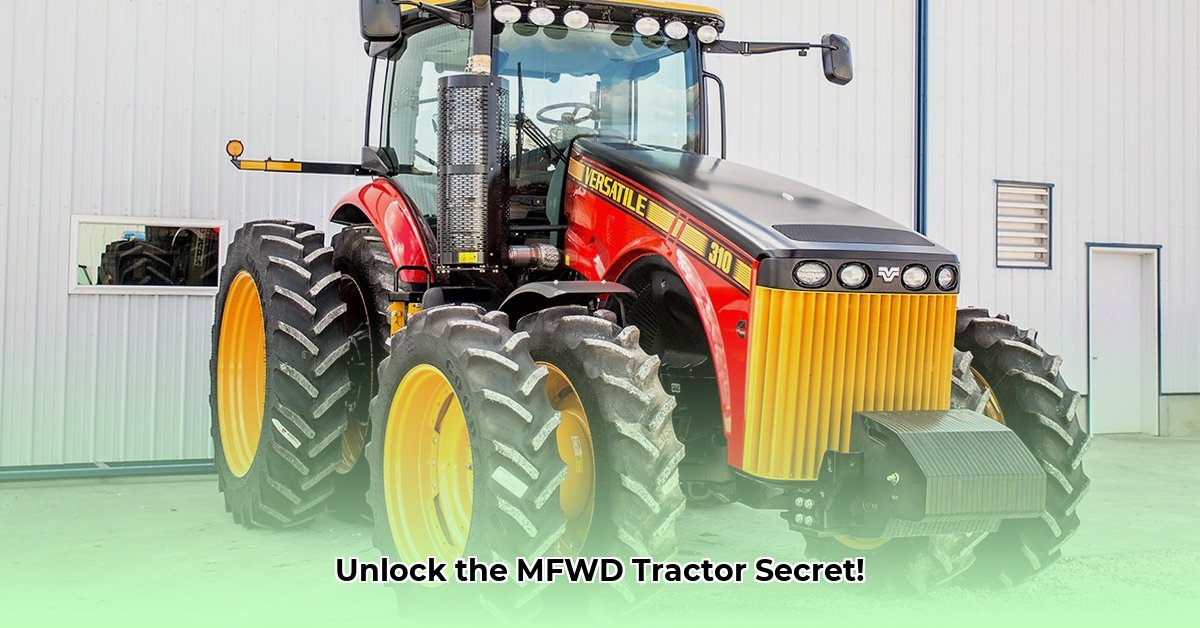
MFWD vs. 4WD Tractors: A Comparative Review for Sustainable Agriculture
Choosing the right tractor is a critical decision for farmers, impacting both productivity and environmental sustainability. This article compares Mechanical Front Wheel Drive (MFWD) and Four-Wheel Drive (4WD) tractors, analyzing their strengths and weaknesses within the context of sustainable farming practices. For more tractor types, see this helpful guide: Tractor Types.
Understanding the Fundamentals: MFWD vs. 4WD
The core difference lies in power distribution. 4WD tractors constantly power all four wheels, providing maximum traction in challenging conditions like steep slopes or heavy mud. MFWD tractors, however, only engage the front wheels mechanically when additional traction is required. This seemingly small difference significantly impacts fuel efficiency, soil compaction, and maneuverability. Think of it this way: a 4WD is a powerful workhorse, always ready for the toughest jobs, while an MFWD offers efficient performance for most tasks, utilizing its extra power only when needed. Which approach better suits your farm's specific needs?
MFWD Tractors: Fuel Efficiency and Soil Health Champions
MFWD tractors offer several key advantages aligned with sustainable agriculture:
Fuel Efficiency: By engaging front-wheel drive only when necessary, MFWD tractors significantly reduce fuel consumption compared to 4WD. This translates to substantial cost savings and a reduced carbon footprint. How much could you save annually on fuel costs by switching to an MFWD tractor?
Reduced Soil Compaction: The lower, on-demand power application minimizes soil compaction. This improves water infiltration, root growth, and overall soil health, vital for long-term farm sustainability. What's the long-term impact of soil compaction on your crop yields?
Enhanced Maneuverability: MFWD tractors generally offer better maneuverability, particularly beneficial for precision farming techniques and smaller fields. This precision reduces crop damage and increases efficiency. Does better maneuverability translate into increased yield per acre?
4WD Tractors: Power and Traction When It Matters Most
While MFWD tractors excel in many areas, 4WD systems retain advantages in specific situations:
Superior Traction: 4WD provides unmatched traction in extremely challenging conditions such as heavy mud, steep inclines, or when pulling heavy implements. Is the added traction of a 4WD essential for your specific farming practices?
Increased Pulling Power: For larger-scale operations requiring heavy tillage or significant pulling power, 4WD is typically necessary to consistently maintain optimal performance. Could an MFWD handle the demands of your heaviest tillage operations?
Choosing the Right Tractor: A Step-by-Step Decision-Making Process
Selecting between MFWD and 4WD requires careful consideration of several factors:
Assess Your Farming Operations: Analyze the tasks you perform regularly, the types of soil you work with, and the size and weight of your implements.
Compare Tractor Specifications: Closely examine fuel efficiency ratings, horsepower, and traction system details. Consult your local dealer for clarification.
Conduct a Thorough Test Drive: Experience the tractor's handling and performance under conditions similar to your farm. This hands-on experience is invaluable.
Calculate Total Costs: Factor in the initial purchase price, maintenance, fuel costs, and potential repair expenses over the tractor's lifespan.
The Verdict: Aligning Tractor Choice with Sustainable Farming Goals
“The decision of whether to choose an MFWD or 4WD tractor is not a simple one," says Dr. Emily Carter, Agricultural Engineer at Purdue University. "It's crucial to consider the long-term implications for both profitability and environmental sustainability.”
Ultimately, the "MFWD tractor meaning" extends beyond a simple definition; it represents a strategic choice between efficiency and raw power. The optimal choice depends entirely on your individual farming practices, budget, and long-term sustainability objectives. By carefully weighing the pros and cons and performing comprehensive research, you can select the tractor best suited to your farm’s needs and contribute to a more sustainable agricultural future.